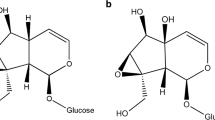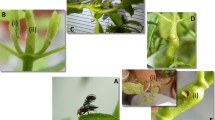Abstract
Egeria densa (Hydrocharitaceae) is a submerged macrophyte from South America that is a weed in several countries. It crowds out native plants and hinders water use, causing economic and environmental damage. The leafminer fly Hydrellia sp. 1 (Diptera: Ephydridae), was found feeding in E. densa throughout its Argentine distribution, and is currently the only known specialist herbivore of E. densa. It was reared in the laboratory and tested on 25 plant species. This herbivore can cause heavy defoliation in the laboratory and in the field. Hydrellia sp. 1 was found only on E. densa, but in the laboratory it also developed on two other Hydrocharitaceae species in the same family; Egeria naias, and Elodea callitrichoides. Significant oviposition and feeding were only observed on its primary natural host, and to a lesser degree on E. naias. Field studies indicate Hydrellia sp. 1 is present in the field year round, unless the host plant is prostrate for long periods, or covered by floating macrophytes. These results indicate Hydrellia sp. 1 may be a suitable biocontrol candidate for E. densa.


Similar content being viewed by others
References
Baars JR, Coetzee JA, Martin G, Hill MP, Caffrey JM (2010) Natural enemies from South Africa for biological control of Lagarosiphon major (Ridl.) Moss ex Wager (Hydrocharitaceae) in Europe. Hydrobiologia 656:149–158
Balciunas JK, Burrows DW, Purcell MF (1996) Australian surveys (1985–1992) for insect biological control agents of Hydrilla verticillata. Technical Report A-96-5. U.S. Army Engineer Waterways Experiment Station, Vicksburg, Mississippi, USA
Balciunas JK, Grodowitz MJ, Cofrancesco AF, Shearer JF (2002) Hydrilla. In: Van Driesche R, Blossey B, Hoddle M, Lyon S, Reardon R (eds) Biological control of invasive plants in the eastern United States. United States department of agriculture forest service. Forest Health Technology Enterprise Team. Morgantown, pp 91–114
Bini LM, Thomaz SM (2005) Prediction of Egeria najas and Egeria densa occurrence in a large subtropical reservoir (Itaipu Reservoir, Brazil-Paraguay). Aquat Bot 83:227–238
Borges Neto CR, Pitelli RA (2004) Adjuvantes e herbicidas e a infectividade de Fusarium graminearum, agente potencial de biocontrole de Egeria densa e Egeria najas. Planta Daninha 22:77–83
Cabrera Walsh G, Schooler S, Julien M (2011) Biology and preliminary host range of Hydrotimetes natans Kolbe (Coleoptera: curculionidae), a natural enemy candidate for biological control of Cabomba caroliniana Gray (Cabombaceae) in Australia. Aust J Entomol 50:200–206
Camargo AFM, Pezzato MM, Henry-Silva GG, Assumpçao AM (2006) Primary production of Utricularia foliosa L., Egeria densa Planchon and Cabomba furcata Schult and Schult.f from rivers of the coastal plain of the State of Sao Paulo Brazil. Hydrobiologia 570:35–39
Casati P, Lara MV, Andreo CS (2000) Induction of a C4-like mechanism of CO2 fixation in Egeria densa, a submersed aquatic species. Plant Physiol 123:1611–1622
Casati P, Lara MV, Andreo CS (2002) Regulation of enzymes involved in C4 photosynthesis and the antioxidant metabolism by UV-B radiation in Egeria densa, a submersed aquatic species. Photosynth Res 71:251–264
Catálogo de plantas vasculares Argentinas (2008) http://www2.darwin.edu.ar/. Accessed on 11 sept 2008
Díaz NB, Gallardo FE, Gaddi AL, Cabrera Walsh G (2009) Description of a new genus and species of Eucoilinae (Hymenoptera: cynipoidea: figitidae) parasitoid of Ephydridae (Diptera). Ann Entomol Soc Am 102:603–607
Dutartre A, Haury J, Jigorel A (1999) Succession of Egeria densa in a drinking water reservoir in Morbihan (France). Hydrobiologia 415:243–247
EDCP (2006) State of California department of boating and waterways Egeria densa control program. Aquatic weed program, California department of boating and waterways. Sacramento, California, p 205
Feijoó CS, Momo FR, Bonetto CA, Tur NM (1996) Factors influencing biomass and nutrient content of the submersed macrophyte Egeria densa Planch. in a pampasic stream. Hydrobiologia 341:21–26
Feijoó C, García ME, Momo F, Toja J (2002) Nutrient absorption by the submerged macrophyte Egeria densa Planch.: effect of ammonium and phosphorus availability in the water column on growth and nutrient uptake. Limnetica 21:93–104
Freedman JE, Grodowitz MJ, Cofrancesco AF, Bare R (2001) Mass-rearing Hydrellia pakistanae Deonier, a biological control agent of Hydrilla verticillata (L.f.) Royle, for release and establishment. Aquatic plant control research program ERDC/EL TR-01-24, U.S. Army Corps of Engineers, Washington, DC, p 33
Gassmann A, Cock MJW, Shaw R, Evans HC (2006) The potential for biological control of invasive alien aquatic weeds in Europe: a review. Hydrobiologia 570:217–222
Greenberg SM, Sap**ton TW, Sétamou M, Liu T-X (2002) Beet armyworm (Lepidoptera: noctuidae) host plant preferences for oviposition. Environ Entomol 31:142–148
Haramoto T, Ikusima I (1988) Life cycle of Egeria densa Planch., an aquatic plant naturalized in Japan. Aquat Bot 30:389–403
Heard TA (2000) Concepts in insect host-plant selection behaviour and their application to host specificity testing. In: Van Driesche R, Heard T, McClay A, Reardon R (eds) Host specificity of exotic arthropod biological control agents: the biological basis for improvement in safety. Forest Service, Morgantown, pp 1–10
Howard-Williams C (1993) Processus of aquatic weed invasions: the New Zealand example. J Aquat Plant Manage 31:17–23
Johnson RL, Blossey B (2002) Eurasian watermilfoil. In: Van Driesche R, Blossey B, Hoddle M, Lyon S, Reardon R (eds) Biological control of invasive plants in the eastern United States. United States department of agriculture forest service, Forest Health Technology Enterprise Team. Morgantown, pp 79–90
Kula RR, Martinez JJ, Cabrera Walsh G (2009) Supplement to revision of New World Chaenusa Haliday sensu lato (Hymenoptera: braconidae: alysiinae). Proc Entomol Soc Wash 111:641–655
Mazzeo N, Rodríguez-Gallego L, Kruk C, Meerhoff M, Gorga J, Lacerot G, Quintans F, Loureiro M, Larrea D, García-Rodríguez F (2003) Effects of Egeria densa Planch. beds on a shallow lake without piscivorous fish. Hydrobiologia 506–509:591–602
Pennington TG, Sytsma MD (2009) Seasonal changes in carbohydrate and nitrogen concentrations in Oregon and California populations of Brazilian Egeria (Egeria densa). Invasive Plant Sci Manage 2:120–129
Pierini SA, Thomaz SM (2004) Effects of inorganic carbon source on photosynthetic rates of Egeria najas Planchon and Egeria densa Planchon (Hydrocharitaceae). Aquat Bot 78:135–146
Sato H, Kondo T (1981) Biomass production of waterhyacinth and its ability to remove inorganic minerals from water. 1. Effect of the concentration of culture solution on the rates of plant growth and nutrient uptake. Jpn J Ecol 31:257–267
Schooler S, Cabrera Walsh G, Julien M (2009) Cabomba caroliniana Gray (Cabombaceae). In: Muniappan R, Reddy GVP, Raman A (eds) Biological control of tropical weeds using arthropods, chap 6. Cambridge University Press, Cambridge, pp 87–107
Sorrel BK (1987) Gas transport and storage processes in the lacunar system of Egeria densa Planch. PhD thesis, University of Auckland, New Zealand, 271 pp
SYSTAT Software, Inc. (2004) SYSTAT 11. Richmond
Tanaka N, Setoguchi H, Murata J (1997) Phylogeny of the family Hydrocharitaceae inferred from rbcL and matK gene sequence data. J Plant Res 110:329–337
Tavecchio WLG, Thomaz SM (2003) Growth and photosynthesis of the submerged plant Egeria najas Planchon under low light intensities. Braz Arch Biol Technol 46:203–209
Thiery D, Visser JH (1986) Masking of host plant odour in the olfactory orientation of the Colorado potato beetle. Entomol Exp Appl 41:165–172
Wells RDS, Clayton JS (1991) Submerged vegetation and spread of Egeria densa Planchon in Lake Rotorua, Central North Island, New Zealand. N.Z. J Mar Freshw 25:63–70
Wheeler GS, Center TD (1996) The influence of hydrilla leaf quality on larval growth and development of the biological control agent Hydrellia pakistanae (Diptera: ephydridae). Biol Control 7:1–9
Yarrow M, Marín VH, Finlayson M, Tironi A, Delgado LE, Fischer F (2009) The ecology of Egeria densa Planchon (Liliopsida: alismatales): a wetland ecosystem engineer? Rev Chil Hist Nat 82:299–313
Zilahi-Balogh GMG, Salom SM, Kok LT (2003) Temperature-dependent development of the specialist predator Laricobius nigrinus (Coleoptera: derodontidae). Environ Entomol 32:1322–1328
Acknowledgments
We wish to thank Wayne Mathis for important data on Ephydridae in general, and ours in particular; Sebastián Pelizza, Norma Díaz, Robert Kula, Fabiana Gallardo, Juan José Martínez and Ana Gaddi for taxonomic work on the Hydrellia sp. 1 natural enemies. We would also like to thank Michael Grodowitz, Julie Coetzee, and two anonymous reviewers for many useful comments on earlier versions of the manuscript.
Author information
Authors and Affiliations
Corresponding author
Additional information
Handling Editor: Eric Wajnberg
Rights and permissions
About this article
Cite this article
Cabrera Walsh, G., Magalí Dalto, Y., Mattioli, F.M. et al. Biology and ecology of Brazilian elodea (Egeria densa) and its specific herbivore, Hydrellia sp., in Argentina. BioControl 58, 133–147 (2013). https://doi.org/10.1007/s10526-012-9475-x
Received:
Accepted:
Published:
Issue Date:
DOI: https://doi.org/10.1007/s10526-012-9475-x




